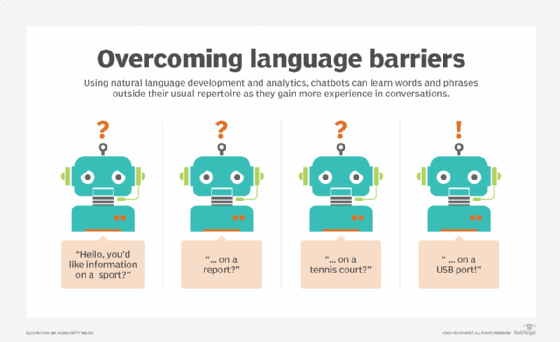
Getty Images/iStockphoto
How businesses can benefit from conversational AI applications
Conversational AI tools have traditionally been limited in scope, but as they become more humanlike, businesses have realized their potential and applied them to more use cases.
As is the case with other emerging branches of AI, the capabilities of conversational AI tools are systematically improving, thereby ensuring these tools are no longer relegated to simplistic queries and answers with consumers.
Conversational AI is making its way into more types of applications, such as getting answers to customer service questions or checking HR policies. The most obvious use cases for conversational AI are chatbots or digital assistants that answer repetitive questions. However, augmented analytics platforms are also taking advantage of conversational AI to allow more people in an organization to interact with data. Instead of typing an SQL query, a business user can simply type a natural language query which is answered in natural language.
Conversational AI is enabled by natural language processing (NLP) , specifically natural language understanding (NLU) to determine what a user is trying to communicate and natural language generation (NLG) to respond back to that person. It also uses machine learning to constantly improve its accuracy.
One major criticism of conversational AI is that it doesn't understand human emotion, though that's changing. The more human AI appears and behaves, the less likely it is for an interaction to be escalated.

Understanding the human factor
Frustrated customers often change the volume of their speech to help convey their present state of mind. For example, a typed message may contain the use of all caps and exclamation points to express anger. By using semantics to understand the relationships of words and reinforcement learning, conversational AI is improving.
"Conversational AI can comprehend human characteristics such as pauses, repetition, tone and even sarcasm," said Jason McMahon, digital strategist at Australian digital marketing agency Bambrick. "These are fundamental tools of human communication that conversational AI may quickly pick up on to make encounters more engaging for both customers and enterprises."
Digital assistants, such as Siri and Alexa, demonstrate how mainstream conversational AI has become, though the results of such interactions can be spurious. While the mistakes are usually only mildly annoying from a consumer point of view, mistakes in a business context could be very costly, both monetarily and reputationally.
McMahon said conversational AI applications can use NLP to understand sentiment by classifying customer behavior as positive, negative or neutral, which enables a chatbot to respond to the user appropriately. Still, many emotions are only shades of positive, negative or neutral and humans expect AI to understand those nuances.
Context is critical
What a person says or types can be easily misunderstood in the absence of knowing the user's context. However, one can infer a set of potential interactions depending on whether the person is using a retail app or a travel booking app, for example.
Computer vision is also being used to identify behaviors and body language which provide additional context. While words are central to conversational AI, nonverbal clues can emphasize or even contradict what a person is saying. In short, the more information the AI has about a user at a specific moment in time, the more accurately it can determine what action to take.
AI platforms are also gathering data that can be used for training. For example, sports and entertainment event ticketing company AXS realized its call center staff could no longer handle the massive backlog of questions, so the company decided to implement Satisfi Labs' conversational AI platform. Satisfi's AI assistants learn from the shared knowledge gathered from 350 customer organizations using the platform. Ultimately, AXS managed to reduce live escalations to 6% of all traffic and saved about $900,000.
Right-sizing conversational AI to suit the use case
Authenticx, another conversational AI platform provider, analyzed 50,000 customer interactions to better understand and improve customer experience in healthcare. It discovered the following:
- On a daily basis, 25% of healthcare customers are stuck in their customer journey.
- It costs an average of $323,000 monthly to resolve those disruptions.
- Healthcare organizations face $3.8 million in average annual costs related to agent time and resources.
- A single client was responsible for 60% of status check calls about claims and general treatment.
With this insight, both complaints and billing statement-related costs can be significantly reduced.
In cybersecurity-related use cases, security and IT analysts rely on conversational AI applications "heavily," according to Anurag Gurtu, chief product officer at StrikeReady. Specifically, conversational AI is being used to deal with alerts and incidents.
"Conversational AI in cybersecurity goes beyond knowledge search to include hundreds of tasks and operations," Gurtu said. "Among the benefits customers can expect include enhanced ROI on IT and security investments; improved security; lower operating costs; and increased speed, accuracy and scale."
As the world becomes increasingly digital, conversational AI applications will become even more common. The more humanlike and accurate an interaction with a machine is, the more humans are inclined to trust it.








